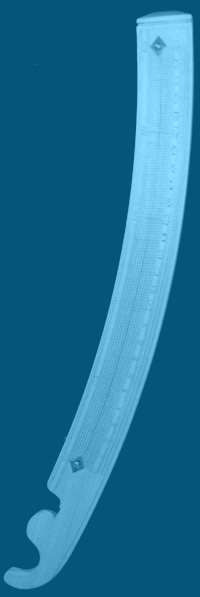1590 Master Hood's Cross-staff (reconstruction)After finishing the 1618 Demi-cross I continued with the next one on my list: Master Hood's cross-staff.1 It was invented by Master Thomas Hood (1556–1620)2 and first described by him in 1590. He wrote that the instrument had two purposes: "…to take the height of the Sunne and Starres…" and to "…take the length, height, depth or breadth of anything measurable…". So this instrument was designed for both navigation (see figure 1) and land surveying (figure 2). Similar instruments for land surveying did exist before 1590, but these were either for land surveying only or combined with astronomical functions for use on land. Master Hood's cross-staff had to serve the navigator at sea as well and that in a unique way. The instrument has similar features as the cross-staff, but due to its shape it was thought to be more accurate in both applications mentioned above. Just like the cross-staff it has degree scales, but in addition to that it also has proportional scales. The degree scales are divided down to a 10 arc minute level, while the proportional scales contain 1000 divisions along the one yard (0.9144 metres) long staves (see figure 7). The scale divisions were much farther apart than on the cross-staff and in the geometrical application it was more accurate as the staffs could be aligned with the object to be measured. Thanks to this Master Hood's cross-staff would directly give the dimensions from the proportions, while the cross-staff would only give us an angle. Not only was it a land surveying instrument made ready for use at sea, but it also incorporated a new feature: measuring the sun's altitude using its shadow. Although the use was still in a forward manner this instrument influenced a number of people to develop a wide range of shadow casting navigational instruments like the demi-cross, a development that would finally result into the Davis Quadrant. Although the instrument has been described by two authors (Thomas Hood and Thomas Blundeville) for at least 48 years, none of them survived. As none are left I wanted to create this ebony and brass reconstruction using the information both authors left in their books. After a year of research, building the instrument took me about 50 hours. Now the instrument should be a 95% accurate reconstruction of the original. On November 5th, 2007 a field test was carried out in order to judge the usability and accuracy of the instrument. We tried both shadow measuring methods as described in the period literature. During half an hour we managed to get 5 fixes, 3 of them in excess of 8 degrees off. The other two were fixed using the help of a second observer who held the instrument horizontally. The first observer then only had to deal with aligning the two staffs with the sun and reading the instrument. Despite all that the measurements were off by 20.3 and 33.6 arc minutes, something that could easily be achieved with an mariner's astrolabe with less effort. All these observations were done on land, being at sea on a rolling vessel must have made things only worse. An article on the instrument has been published in the March 2011 edition of the Bulletin of the Scientific Instrument Society.1 Notes[1]: For a full description of the instrument see: N. de Hilster, 'Master Hood’s Cross-staff: a reconstruction', in: Bulletin of the Scientific Instrument Society No. 101, (2009), pp.10-17.[2]: H. K. Higton, ‘Hood, Thomas (bap. 1556, d. 1620)’, Oxford Dictionary of National Biography, Oxford University Press, 2004 [http://www.oxforddnb.com/view/article/13680, accessed 12 Oct 2014] If you have any questions and/or remarks please let me know. |
Celestial Navigation... Coastal Navigation... Distance measurement...
1580s Mariner's astrolabe 1590 Hood's cross-staff 1618 Demi-cross 1623 hoekboog 1660 spiegelboog 1661 Kronan cross-staff 1720 Hasebroek cross-staff 1734 Davis quadrant Early 19th c. ebony octant Late 19th c. brass octant 1941 U.S. Navy quintant Hirado navigation set PhD thesis








